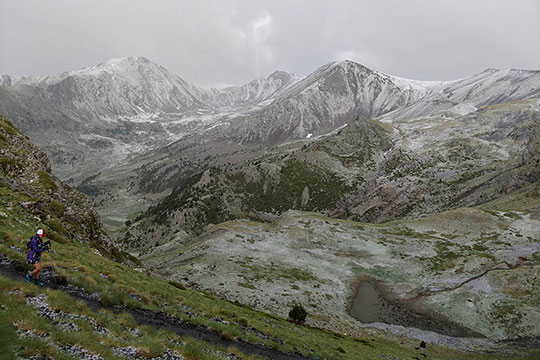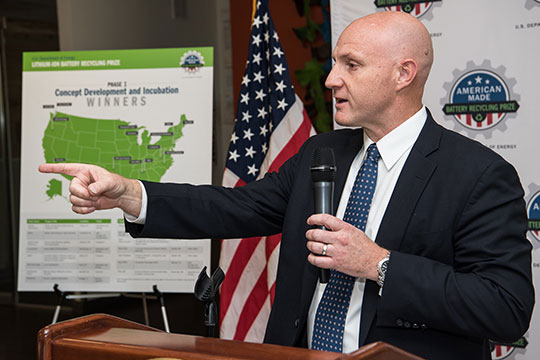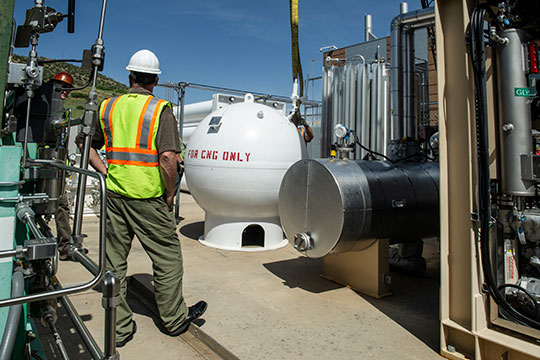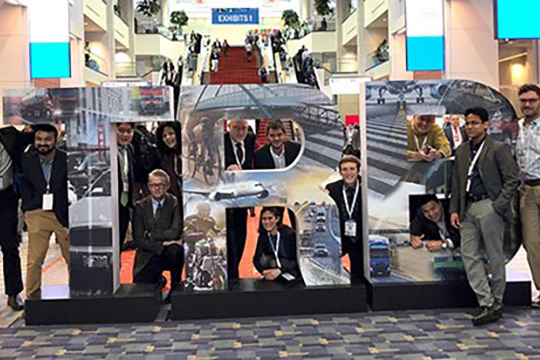Integrated Mobility Sciences Newsletter—Spring 2020
This quarterly newsletter highlights recent projects, partnerships, and publications related to NREL's energy-efficient mobility research.
Subscribe to receive this newsletter via email.

Powering Forward: NREL's Commitment to the Future of Sustainable Mobility
COVID-19 is reshaping the fabric of our work and social lives across the United States and around the world. Here at NREL, we are closely monitoring and following COVID-19 guidance as outlined by public health experts and have placed paramount importance on the health and safety of our NREL employees.
But here's the thing: I am constantly inspired by the collaborative spirit, commitment, and proactivity of NREL researchers, who drive our nation’s transportation goals forward even during times of uncertainty. Responding to challenges like these is at the core of our NREL team’s identity: solving sustainable mobility challenges through flexibility, teamwork, and a deep commitment to world class transportation and mobility research.
I hope this newsletter gives you a taste of how our research team continues to push the boundaries of affordable, high-performance, and energy-efficient transportation technologies and systems, from supporting advances in a sustainable supply chain for recycling lithium-ion batteries to quantifying the energy impact of car crashes at intersections.
Maybe it will brighten your spirit, too.
Stay healthy,
Chris Gearhart
Director, NREL's Center for Integrated Mobility Sciences

Workshop Merges Science and Art to Explore Urban Electrification and the Future of Cities
Science fiction authors and graphic artists from the Denver area joined NREL researchers as they unharnessed their imaginations during a unique workshop that used science fiction as a lens to explore the technological, social, and cultural aspects of a transition to a clean energy future in cities. A collaboration between NREL and Arizona State University, the workshop brought together a cross-disciplinary group of experts to create narratives of hope and visions for the future—inspiring art, short stories, and essays for a book titled The Weight of Light, Volume II. For more information, read the news story.

Fuels Researcher Gina Fioroni Runs Past Lab—and Trail—Obstacles
If you're looking for an inspirational woman in STEM, look no further. From applying her chemistry expertise in the pursuit of better transportation fuels, to being the first American woman to finish the 144-mile Eufòria dels Cims in Andorra, her tenacity is ever-present. "Nothing ever goes the way you planned," Fioroni said. Her determination in the face of that drives her success both on the trail and in her 10 years at NREL. Learn more about this intellectual adventurer in the news story.

Energy Storage Researcher Recognized with 2020 Young Scientist Award
In February 2020, Donal Finegan, a staff scientist at NREL, received the 2020 Young Scientist Award for his groundbreaking work at the European Synchrotron Radiation Facility. Finegan has collaborated closely with the facility throughout his career, focusing on the degradation and failure mechanisms of lithium-ion batteries. As part of this research, he pioneered high-speed X-ray imaging for diagnosing battery failure with implications across the materials science spectrum. In a recent Nature Communications article, Finegan expanded on his findings, which showed the ways in which each particle reacts differently to the incorporation of lithium into the battery electrode.

Study Assesses the Energy Equivalence of Transportation Safety at Intersections
NREL researchers developed a framework for estimating the energy equivalence of transportation safety at intersections. The results of a study employing the framework indicate that the indirect energy impacts dwarf the direct energy impacts for property-damage-only crashes (i.e., no injuries or fatalities) as well as for crashes that result in injuries and fatalities. Additionally, the total direct gross-domestic-product-weighted energy impacts of property-damage-only crashes are more than three times greater than the energy impacts of induced congestion alone, underscoring the value of collision-avoidance technologies for benefits beyond safety.

Lithium-Ion Battery Recycling Prize Innovators Identifying Industry Partners
In February 2020, Lithium-Ion Battery Recycling Prize participants attended the NAATBatt Annual Meeting and Conference to give short pitch presentations about their Phase I concept proposals, plans for Phase II prototyping, and partnering objectives. The teams have just entered Phase II of the Prize, which focuses on building partnerships to develop a comprehensive end-to-end lithium-ion battery recycling solution. Interested industry partners can learn more about these big ideas and contact the winning teams on the Lithium-Ion Battery Recycling Prize website.

Declining Renewable Costs Drive Focus on Energy Storage
Declining costs in available technologies have propelled interest in energy storage like never before, and as communities and entire states push toward higher percentages of power from renewables, there’s no doubt storage will play an important role. NREL's energy storage research spans a range of applications and technologies—including electrochemical storage, seasonal storage using hydrogen, grid-integrated stationary battery technologies, and storage for transportation. To learn how NREL researchers are advancing storage technologies to accelerate the integration of renewables into mobility applications and the grid, read news story.

National Meeting Spotlights Innovative Mobility Research
Several NREL researchers participated in the 99th Annual Meeting of the Transportation Research Board earlier this year in Washington, D.C. A variety of posters and presentations highlighted NREL's work on various mobility topics, including the lab's leadership within the U.S. Department of Energy's (DOE's) SMART Mobility Laboratory Consortium. For more information about the consortium, see the DOE website.
NREL topics focused on automated vehicles, first-mile/last-mile connectivity, ride-sharing, electric vehicle infrastructure, megawatt-level charging stations for heavy-duty electric vehicles, employer-provided mobility, rural mobility, the energy equivalence of safety, and transportation efficiency metrics. The meeting brought together more than 13,000 transportation professionals from around the world.
Get to Know Our Team: Sreekant Narumanchi
Sreekant Narumanchi leads NREL's power electronics and electric machines research, which focuses on systems for electric-drive vehicles that control the flow of electricity between the battery, motor, and other powertrain components. At NREL for more than 15 years, he is the recipient of numerous awards and honors recognizing his research achievements. In March 2020, the American Society of Mechanical Engineers (ASME) designated him as a fellow in honor of his extensive involvement with the organization and his excellence in mechanical engineering research. Previously, he received ASME's Electronic and Photonic Packaging Division Clock Award for advancing the science and engineering of heat transfer in electronics as well as an R&D 100 Award for his contributions to wide bandgap power electronics research.

Must Reads
An NREL-developed methodology for estimating the value of public charging infrastructure for electric vehicles (EVs) hinges on the tangible benefits of enabling additional miles of travel—thereby mitigating range anxiety for EV drivers—and substituting electricity for gasoline for plug-in hybrid electric vehicles. The results of a recent study quantifying the value of public charging infrastructure for EV owners indicate that such infrastructure can offset a substantial fraction of the perceived cost penalty due to EVs' limited range and long recharging time. Read the Transportation Research article.
A Greenville, South Carolina, pilot project showcasing fixed-route automated electric shuttles and in-route wireless charging was the subject of an NREL optimization analysis geared to determine the ideal number and location of wireless chargers, charging power level, track length, and on-board battery capacity. The results specify that implementing high-power (~100 kW) wireless chargers at a few designated stops will allow the vehicles to realize charge-sustaining operation, unlimited driving range, and zero recharge downtime, with a significant reduction in on-board batteries (~36%). Read the IEEE Transactions on Industry article.
While adding a hybrid propulsion system to medium- and heavy-duty vehicles can provide a significant fuel economy advantage, many vehicles also exhibit an increase in tailpipe NOx emissions. In an effort to better understand the cause of this emissions increase, and take steps to address the issue, NREL performed a series of studies employing a chassis dynamometer and portable emissions measurement system. Read the NREL report.
Did You Know?
The director of NREL's Center for Integrated Mobility Sciences, Chris Gearhart, was recently appointed as chair elect of the Sustainable Electrified Transportation Center (SELECT). SELECT is dedicated to developing sustainable solutions for transportation electrification and advancing technologies, partnerships, standards, and policies that foster widespread adoption.
In the News
National Geographic took the great American road trip in electric cars. To see what it learned at NREL along the way, read the National Geographic article.
A Washington Post article covering California's continued interest in hydrogen vehicles features NREL estimations of hydrogen fuel prices from 2020 to 2025.
Learn about the promising results of an expansive analysis of biodiesel quality across the United States and Canada that NREL's Teresa Alleman conducted in partnership with the National Biodiesel Board.
The future is now. Read a Denver Post article to learn about the EasyMile electric, self-driving shuttle advancing the science of autonomous vehicles in NREL's living lab ecosystem.
Share

